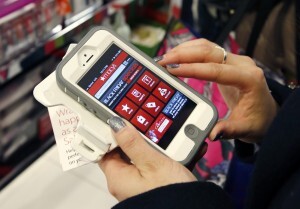
Tashalee Rodriguez, of Boston, uses a smartphone app while shopping at Macy's in downtown Boston. For the first time, analysts predicted that more than half of online traffic to retailer sites would come from smartphones than desktops during the busy Black Friday holiday shopping weekend. (Associated Press)
If the beginning of the holiday season is any indication, it could be a merry mobile Christmas for shoppers.
For the first time, there's expected to be more people visiting retailers' web sites through their smartphones than on desktop computers or tablets during the first weekend of the holiday shopping season that begans on Thanksgiving Day.
Mobile traffic during the five-day start to what is typically the busiest shopping period of the year was expected to reach 56.9 percent of total traffic, up from 48.5 percent last year, according to IBM Watson.
And even though everyone who 'window shops' on their phones isn't going to buy, mobile sales are jumping too. Mobile sales are expected to account for 36.1 percent of online sales, up from 27 percent last year, according to IBM Watson Trend.
The bumps in traffic and sales come as retailers try to make the mobile shopping experience easier by improving their mobile apps and adding coupons and other deals. Shoppers also have gotten more comfortable browsing retailers' web sites as smartphone screen sizes have gotten bigger, making it easier for them to see photos of the items they want to buy. Digital wallets and apps that let shoppers store payment information are helping too.
'It's very convenient,' said Seth Reineke, 25, an insurance worker from Iowa City, Iowa, who planned to peruse Amazon's weekend deals from his phone. 'It allows me to keep track of time-sensitive sales without being tied to a computer or having to leave a holiday event or get-together.'
Overall spending this season is expected to be somewhat muted. The National Retail Federation, a trade group for storeowners, expects industry-wide sales to be up 3.7 percent in November and December, less than the 4.1 percent of last year's holiday season.
But online spending figures are stronger. Forrester predicts online sales will rise 11 percent to $95 billion. And mobile sales are becoming a bigger piece of that pie. Forrester expects them to account for 35 percent of e-commerce this year and 49 percent in five years. That compares to 29 percent in 2014.
Adobe, which measures 80 percent of online sales from the top 100 U.S. retailers, predicts 40 to 45 percent of all retail traffic during November and December will come from mobile devices, up from 37 percent last year. Mobile sales are expected to total 20 to 25 percent of total online sales, up from 16 percent last year.
Wal-Mart, the world's largest retailer, expects that 75 percent of U.S. traffic to its website will come from mobile devices this holiday shopping season. That's up from 50 percent two years ago. Likewise, eBay says it expects mobile sales during the holidays will be 'significantly' higher than the 41 percent mobile sales made up of total revenue in the third quarter.
Thanksgiving and the day after the holiday known as Black Friday are expected to be particularly mobile-friendly shopping dates because people can use their phones to take advantage of limited-time offers wherever they may be. Adobe predicts mobile will drive the majority of shopping traffic, 51 percent, for the first time on Thanksgiving Day.
'There's a lot of opportunity to do 'shopping under the table' on Thanksgiving Day,' said Tamara Gaffney, director of Adobe Digital Index. 'In between cooking, watching football and in general hanging around family and friends, there's down time to glance at the iPad and smartphone and do some shopping.'
Take Danyell Taylor, 34, a writer in Washington, D.C. who likes the 'easy access' of smartphone shopping. Taylor plans to start looking for holiday deals on Wednesday and continuing through the weekend, specifically for Converse shoes and Kate Spade home accessories.
'I'm going to sit on my couch with my phone and my laptop and buy from there,' she says. 'I don't plan on going into the store at all.'
Mobile shopping still has its problems, including security concerns, sluggish apps and hard-to-navigate mobile web sites. And much of mobile traffic doesn't translate into sales.
But for shoppers, the convenience factor is hard to beat, says Forrester Research analyst Sucharita Mulpuru.
'While retailers may lament their low conversion rates and slow download speeds on mobile devices, shoppers still keep shopping on those devices,' Mulpuru says, adding that shoppers 'appear to have greater tolerance for imperfection, much like in the early days of desktop.'
Jill Markiewicz, 38, a personal shopper in New York, says she shops frequently on her iPhone 6s on Saks Fifth Ave and J.Crew's mobile web sites.
'I'm typically on foot running around a lot ... don't get a whole lot of desk time,' Markiewicz says. 'You can go from email to checkout cart in a matter of minutes.'